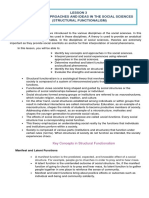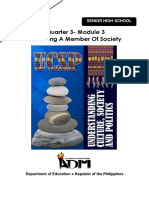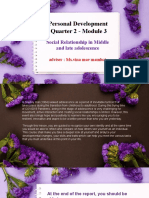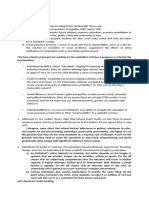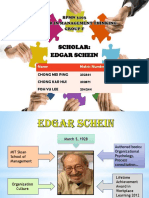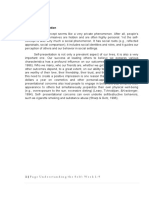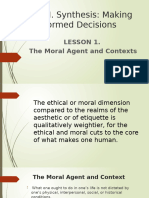Community Dynamics
Uploaded by
hdrfuentesCommunity Dynamics
Uploaded by
hdrfuentesSOCIAL SCIENCE 6
COMMUNITY DYNAMICS AND PROCESSES | MODULE 4.0 LESSON 4.3
At the end of this module, the student should be able to:
• distinguish the concept of power from the concept of authority;
• analyze the importance of skills, capacities, and attitudes in selecting a leader; and
• evaluate the causes of Social Change in the society.
Suggested Time: 1 min | Actual Time Spent: ____min(s)
In the previous module, we identified the community structures. As held previously, community
structures refer to the attributes and characteristics of the relationship by each community component.
These community structures would always relate with community dynamics; so today, we will discuss
this concept. But before we proceed, may I invite your attention to answer the “4-pics 1 word” inspired
pictures:
The answers to these pictures will be revealed during our discussion.
Suggested Time: 4 mins | Actual Time Spent: ____min(s)
Social Science 6: Civic Engagement and Leadership | Page 1 of 6
Community dynamics has something to do with the exchanges, changes, and interaction the
community has experienced as time goes by; and the same happen within the community structures.
These dynamisms are manifested through power relations, leadership, and social change in the
community.
Power Relations
The well-known Sociologist Max Weber considered power as the tendency of attaining the goals amidst
resistance and opposition of other people. Power is always embedded in any term of office and the
enforcement of the same is normal in a certain society. Power must not be confused with authority, for
while the former may be enforced with coercion or terror, the latter is anchored on legitimacy or legality.
Two (2) types of power structures can be observed in a community: the formal structure (FS) and the
informal structure (IS). When we say formal structure, we refer to the legal-authoritative basis of
enforcing power. In our current system, this refers to the exercise of power not only by our elected and
appointed officials, but even by civic leaders as well. Meanwhile, informal power structure co-exists
with the formal structure. Informal structure is hard to define, but simply put, these are the powers
enforced by other people or entity that do not belong under the formal structure. Informal structure is
equally significant with the formal structure in relation with community development.
In examining power relations in the community, it is important to take note of the following elements:
the actors, the stakeholders, and the resources.
a. Actors are the active elements. They can either be the legal-authoritative decision makers or
the influencers. The former’s source of power are the formal rules and institutions, as defined
by the manner on how they assumed office – election or appointment. On the other hand, the
latter are those people or groups who, despite not having the authority, can shape the decisions
made by the former which can consequently affect the community.
b. Stakeholders are the passive elements. They are the ones who are affected by the enforced
power of the actors.
c. Resources are the subjects of both the actors and stakeholders.
Leadership
Understanding it within the context of community, leadership pertains to both the means and attributes
of command and decisiveness manifested by a person to ensure a good outcome for the community.
Hence, an individual’s selection as a leader is either through nomination, appointment or election which
is also premised on the assumption that he or she is the right person to handle a particular concern in
the community. This established assumption finds bearing from his /her demonstrated skills, capacities,
and attitudes.
To further understand leadership, it is important to note how Max Weber classified leadership through
Ideal Types. This is otherwise known as the Theory of Authority and Legitimacy, which classifies a
leader as either traditional, charismatic, or rational.
a. Traditional leaders are those who claim that authority is innately vested in them; and such claim
is validated by the followers’ beliefs. He is considered not as a superior, but instead, a personal
master.
b. Charismatic leaders are those whose authority is based on the perception of his/her follower
that he/she is charismatic—having extraordinary personal qualities. A charismatic leader is
someone who can effect changes or bring internal reorientation among his/her members.
Social Science 6: Civic Engagement and Leadership | Page 2 of 6
c. Rational leaders are those who determine the end or goal of the community or society, with the
aid of legally enacted rules and regulations. Through these rules and regulations, he/she
gradually compels members to adapt change to finally meet the set goal.
Social Change
Social Change is the modification in the patterns observed in a particular organization or of the society.
These patterns are in the form of culture, social structure, or social behavior. These are manifested
through the rise and fall of a particular group, change in the statuses and roles in various institutions, or
change in the community structures and functions. Inasmuch as social change is universal, its pacing
and rate vary depending on the type of society. Interestingly, indigenous people have a high tendency
to resist social change due to high cultural familiarity and total adaptation to their environment.
As pointed out by Shelly Shah, there are five (5) causes of Social Change, and these are cultural change
(through invention, discovery and diffusion), introduction of new ideas and modification of the old
ones, demographic change, presence of tension and conflict, and social movement.
There is invention when a new combination or a new use is applied to any existing knowledge. There
is discovery when as people tend to reorganize existing elements in the world, they noticed something
new or perceived such existing element in a new way. Invention and discovery are in most cases
affected by technology. With the advancement of technology, rate of social change also increases due
to the opening of so many possibilities.
On the other hand, diffusion is a different thing. Diffusion is the spread of cultural attributes from one
group to another. Some of its identified agents are trade, migration, and mass communication.
The introduction of new ideas or modification of the old ones may be exemplified by Max Weber’s
rationalization of religious ideas that later changed the views of the Protestant world.
Any change in demographic attribute contributes to social change. These attributes are birth rate, death
rate and migration of people.
Tension and conflict are contributory factors to social change since whenever people in the community
feel deprivation, structural strain, or sees the need for cultural revitalization, they would assert changes.
Social movement refers to efforts made by a particular group with an attempt to cause change on the
norms, traditions, relationships, institutions, and values, with the end of introducing a new identity or
perspective.
At this point, let us go back to “4 Pics 1 Word” inspired activity at the beginning of this module.
Looking at the four pictures for set 1, the common word (or answer) is “MESSAGE”. As to set 2, the
answer is “GREET”.
But apart from the commonality of the pictures, something can be observed from each set – the
OBSERVABLE CHANGE THAT OCCURRED – “change” that can be considered “social”.
Note how the mode of conveying or sending message has evolved. And note also how our way of
greeting another person has changed.
Suggested Time: 8 mins | Actual Time Spent: ____min(s)
Social Science 6: Civic Engagement and Leadership | Page 3 of 6
Formative Assessment. The activity is a 10-point graded assessment. Submit your answers via
different modes applicable in your campus or as instructed by your subject teacher. Use the rubric in
the succeeding page as a guide in answering this activity. (5 points for each item)
Criteria Excellent Satisfactory Poor
CONTENT 3 pts. 2 pt. 1pt.
3 pts. Context is well- There is an evidence The context is not
developed; Ideas are of a developed context clear. Ideas may have
well-supported and are but there is a need to questionable
accurate and relevant. add more details for a factuality. Confusion
strong support. of the reader is a
possible outcome.
ORGANIZATION 2 pts. 1 pt. 0 pt.
OF IDEAS
2 pts. There is an evidence Ideas are organized. Coherence between
of clear, effective, However, minimal ideas is not evident.
graceful, coherent inclusions of The reader may find
transition of ideas in irrelevant ideas are difficulty in
the essay. The evident. They do not understanding the
organization aids the affect the essence of collective thought of
reader to understand the essay. the essay.
the connections of the
ideas clearly and
easily to each other.
SYNTAX Not Applicable
The structure and the Minimal distractions Distractions regarding
use of words, regarding syntax are syntax is very evident.
punctuations, and present ie failure to Wrong use of words,
capitalizations in the capitalize a letter, punctuations, and
sentence/s are correct misuse, or lack of capitalizations hinder
and appropriate. punctuations in a the reader to
sentence, and understand the
inappropriate thought/s.
wording. But these
distractions do not
affect the essence of
the essay.
Adopted from: Sir Erin Dela Cruz, Soc Sci Teacher, PSHS Main Campus
1. How is power different from authority? Explain by giving a particular scenario or example.
___________________________________________________________________________
___________________________________________________________________________
___________________________________________________________________________
___________________________________________________________________________
___________________________________________________________________________
Social Science 6: Civic Engagement and Leadership | Page 4 of 6
2. Why are skills, capacities, and attitude important in selecting a leader? Explain.
___________________________________________________________________________
___________________________________________________________________________
___________________________________________________________________________
___________________________________________________________________________
__________________________________________________________________________
Suggested Time: 16 mins | Actual Time Spent: ____min(s)
As part of its dynamics and process, a community is always engaged in so many activities.
These activities are in line with how its people interact.
Having a complete understanding of these dynamics and process would enlighten us on why a
certain community behaves in a particular manner.
In the context of power relations, formal and informal structures are the ones to be considered.
In the context of leadership, it is noted that community members select their leaders and
respond to them through different perspectives and criteria.
In the context of social change, we must not forget that the community becomes dynamic due
to some causes.
Suggested Time: 1 min | Actual Time Spent: ____min(s)
References:
Santarita, J. & Madrid R. (2016). Understanding culture, society, and politics. Quezon City, Phils.:
Vibal Group Inc.
Taguibao, J. & De Guzman, FR. (2016). Community engagement, solidarity, and citizenship.
Quezon City, Phils.: Vibal Group Inc.
Shelly Shah (n.d.). Social development: 5 main causes of social change. Sociology Discussion.
Retrieved from https://www.sociologydiscussion.com/society/social-development-5-main-
causes-of-social-change/963
PHOTO REFERENCES / CREDITS:
(4 pic 1-word Activity Set 1)
https://blog.myheritage.com/2019/03/preserving-old-family-letters/
https://www.yourdictionary.com/telegram
https://www.telegraph.co.uk/technology/mobile-phones/9718336/Text-messaging-at-20-how-SMS-
changed-the-world.html
https://deciphertools.com/blog/how-to-save-facebook-messenger-messages/
(4 pic 1-word Activity Set 2)
https://www.expatica.com/living/integration/greeting-customs-around-the-world-11731/
https://content.artofmanliness.com/uploads//2016/04/shake.png
https://deansomerset.com/high-fives-participation-ribbons/
https://www.shutterstock.com/search/fist+bump
Social Science 6: Civic Engagement and Leadership | Page 5 of 6
Lay-out and Design of Learning Guide Credit:
Nneka B. Evangelista, Soc Sci Teacher, PSHS-CALABARZON Campus
Prepared by: JAY P. BASSIG Reviewed by: Ariel S. Barrias
Position: SST V Position: SST III
Campus: PSHS-BRC Campus: PSHS-CARC
© 2020 Philippine Science High School System. All rights reserved. This document may contain proprietary information and may only
be released to third parties with approval of management. Documents are uncontrolled unless otherwise marked; uncontrolled
documents are not subject to update notification.
Social Science 6: Civic Engagement and Leadership | Page 6 of 6
You might also like
- Mba Project Report On Organizational Culture0% (2)Mba Project Report On Organizational Culture17 pages
- Organizational Culture: Learning ObjectivesNo ratings yetOrganizational Culture: Learning Objectives22 pages
- Quarter 3-Module 3 Becoming A Member of Society: Senior High School100% (1)Quarter 3-Module 3 Becoming A Member of Society: Senior High School12 pages
- Philosophies of Administrative Sciences: Knowledge and Learning100% (1)Philosophies of Administrative Sciences: Knowledge and Learning21 pages
- I. Lesson Lesson 1: Exploring Groups Within Society Specific ObjectivesNo ratings yetI. Lesson Lesson 1: Exploring Groups Within Society Specific Objectives14 pages
- Values, Norms and Social Cognition. Scientific Papers of Naukma: Sociology, 1:3-9No ratings yetValues, Norms and Social Cognition. Scientific Papers of Naukma: Sociology, 1:3-98 pages
- Social System: Click To Edit Master Title StyleNo ratings yetSocial System: Click To Edit Master Title Style21 pages
- Introduction To Social Dimensions of Education100% (6)Introduction To Social Dimensions of Education29 pages
- Purple Wildflowers Photo Background SlidesManiaNo ratings yetPurple Wildflowers Photo Background SlidesMania25 pages
- E-learning 1 Lecture 7 2022 BBA 420 Organisational CultureNo ratings yetE-learning 1 Lecture 7 2022 BBA 420 Organisational Culture96 pages
- Personal and Organizational Mindsets at WorkNo ratings yetPersonal and Organizational Mindsets at Work18 pages
- Ch 1 - Introducing Community Psychology - Spring 2025 (1)No ratings yetCh 1 - Introducing Community Psychology - Spring 2025 (1)34 pages
- Saturday 11:00PM - 2:00PM: Dr. Lovelie V. VercelesNo ratings yetSaturday 11:00PM - 2:00PM: Dr. Lovelie V. Verceles11 pages
- Organisational Culture and Communication SummaryNo ratings yetOrganisational Culture and Communication Summary29 pages
- Importance and Dynamic of Effective Groups in The Development of A Successful Organization100% (1)Importance and Dynamic of Effective Groups in The Development of A Successful Organization7 pages
- Introduction To Social Dimensions of Education100% (1)Introduction To Social Dimensions of Education29 pages
- Insight: Creative Systems Theory's Radical New Picture of Human PossibilityFrom EverandInsight: Creative Systems Theory's Radical New Picture of Human PossibilityNo ratings yet
- EXTRAORDINARY POPULAR DELUSIONS AND THE MADNESS OF CROWDS: Uncovering the History and Psychology of Mass Hysteria and Collective Obsessions (2024)From EverandEXTRAORDINARY POPULAR DELUSIONS AND THE MADNESS OF CROWDS: Uncovering the History and Psychology of Mass Hysteria and Collective Obsessions (2024)No ratings yet
- The Art of Critical Thinking: Sharpening Your Cognitive SkillsFrom EverandThe Art of Critical Thinking: Sharpening Your Cognitive SkillsNo ratings yet
- Pros Cons Influence of Celebrities On Youth CultureNo ratings yetPros Cons Influence of Celebrities On Youth Culture3 pages
- Balus Jan Bialostocki and George Kubler 2010No ratings yetBalus Jan Bialostocki and George Kubler 20108 pages
- Mike Michael - Actor-Network Theory - Trials, Trails and Translations (2017, SAGE Publications)No ratings yetMike Michael - Actor-Network Theory - Trials, Trails and Translations (2017, SAGE Publications)201 pages
- Edwards, Elizabeth (2012) - Objects of Affect. Photography Beyond The ImageNo ratings yetEdwards, Elizabeth (2012) - Objects of Affect. Photography Beyond The Image19 pages
- Chapter-1 - Prof-Ed-3: Philosophical Thoughts On EducationNo ratings yetChapter-1 - Prof-Ed-3: Philosophical Thoughts On Education33 pages
- Instant Access to (eTextbook PDF) for Discover Sociology 4th Edition by William J. Chambliss ebook Full Chapters100% (1)Instant Access to (eTextbook PDF) for Discover Sociology 4th Edition by William J. Chambliss ebook Full Chapters55 pages
- Get Political Psychology a Social Psychological Approach Hewer free all chapters100% (1)Get Political Psychology a Social Psychological Approach Hewer free all chapters65 pages
- Quarter 3-Module 3 Becoming A Member of Society: Senior High SchoolQuarter 3-Module 3 Becoming A Member of Society: Senior High School
- Philosophies of Administrative Sciences: Knowledge and LearningPhilosophies of Administrative Sciences: Knowledge and Learning
- I. Lesson Lesson 1: Exploring Groups Within Society Specific ObjectivesI. Lesson Lesson 1: Exploring Groups Within Society Specific Objectives
- Values, Norms and Social Cognition. Scientific Papers of Naukma: Sociology, 1:3-9Values, Norms and Social Cognition. Scientific Papers of Naukma: Sociology, 1:3-9
- E-learning 1 Lecture 7 2022 BBA 420 Organisational CultureE-learning 1 Lecture 7 2022 BBA 420 Organisational Culture
- Ch 1 - Introducing Community Psychology - Spring 2025 (1)Ch 1 - Introducing Community Psychology - Spring 2025 (1)
- Saturday 11:00PM - 2:00PM: Dr. Lovelie V. VercelesSaturday 11:00PM - 2:00PM: Dr. Lovelie V. Verceles
- Importance and Dynamic of Effective Groups in The Development of A Successful OrganizationImportance and Dynamic of Effective Groups in The Development of A Successful Organization
- Insight: Creative Systems Theory's Radical New Picture of Human PossibilityFrom EverandInsight: Creative Systems Theory's Radical New Picture of Human Possibility
- EXTRAORDINARY POPULAR DELUSIONS AND THE MADNESS OF CROWDS: Uncovering the History and Psychology of Mass Hysteria and Collective Obsessions (2024)From EverandEXTRAORDINARY POPULAR DELUSIONS AND THE MADNESS OF CROWDS: Uncovering the History and Psychology of Mass Hysteria and Collective Obsessions (2024)
- The Art of Critical Thinking: Sharpening Your Cognitive SkillsFrom EverandThe Art of Critical Thinking: Sharpening Your Cognitive Skills
- Pros Cons Influence of Celebrities On Youth CulturePros Cons Influence of Celebrities On Youth Culture
- Mike Michael - Actor-Network Theory - Trials, Trails and Translations (2017, SAGE Publications)Mike Michael - Actor-Network Theory - Trials, Trails and Translations (2017, SAGE Publications)
- Edwards, Elizabeth (2012) - Objects of Affect. Photography Beyond The ImageEdwards, Elizabeth (2012) - Objects of Affect. Photography Beyond The Image
- Chapter-1 - Prof-Ed-3: Philosophical Thoughts On EducationChapter-1 - Prof-Ed-3: Philosophical Thoughts On Education
- Instant Access to (eTextbook PDF) for Discover Sociology 4th Edition by William J. Chambliss ebook Full ChaptersInstant Access to (eTextbook PDF) for Discover Sociology 4th Edition by William J. Chambliss ebook Full Chapters
- Get Political Psychology a Social Psychological Approach Hewer free all chaptersGet Political Psychology a Social Psychological Approach Hewer free all chapters




